Acer rubrum
(Red Maple)
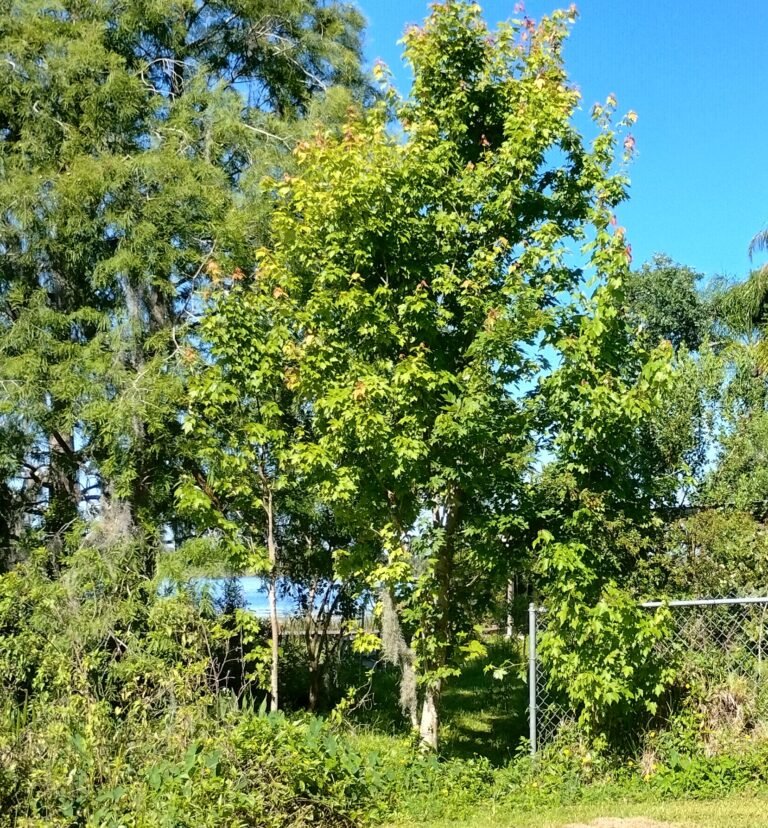
Common Names, Latin Name and Family
Some of its common names are Carolina red maple, scarlet maple, soft maple, swamp maple, water maple, and white maple.
Its Latin name is Acer rubrum.
It is found in the Sapindaceae, soapberry, family.
Maples used to be in their own family called the Aceraceae family but that has been dissolved and is no longer used.
Form
Red maple is a large deciduous, tree that reaches a mature height of 100 feet in ideal conditions.
The National Champion red maple (as of 2019) is located in New Haven County, CT, and measures 72 feet high, 68 foot crown spread, 276 inches in circumference and scores 365 points. Source: https://www.americanforests.org/tree/red-maple-ct/
The Florida Champion red maple is known as Ace and grows in the Green Swamp in Polk County, Florida. Ace has a height of 103 feet, circumference of 166 inches and crown spread around 76 feet. These three measurements are used to award a point total to trees in the register. Ace’s measurements earned enough points to edge out the previous red maple Florida Champion, a 102-foot red maple in Citrus County. [1]
Leaves
Red maple leaves have 3 to 5 lobes are simple, and opposite, with red petioles. The sinuses (the space in between the lobes) are V-shaped and the margins are serrate.
The leaf size can vary from 2 – 6 inches long and 2 – 4 inches wide. The upper leaf surface is green and the lower is gray-white. They are ovate to elliptic in shape with some resembling a small red maple leaf. The margins may be toothed or not and lobed or not.
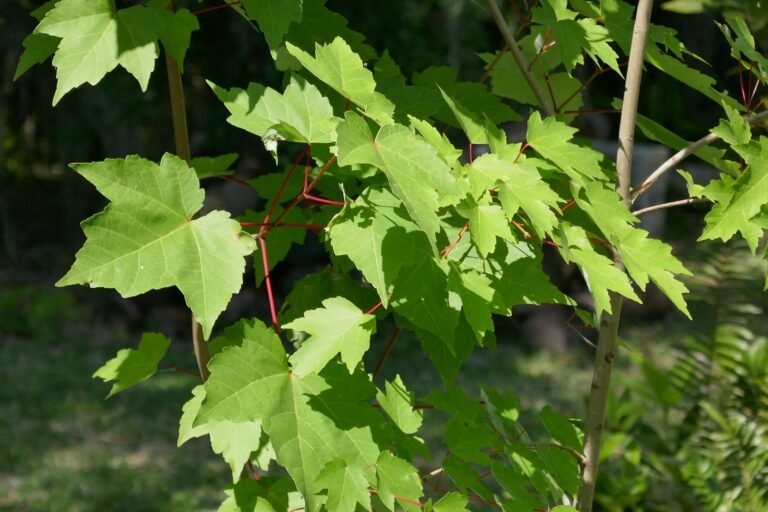
Flowers
Red maple flowers are tiny, red, and appear in late winter before the leaves emerge.
Maples are considered mainly dioecious meaning that male and female flowers are found on separate trees so a particular tree is either female or male.
However, some maples can be polygamo-dioecious where they have perfect flowers (bisexual with male and female parts) along with the majority of that tree’s flowers which might be male (staminate) or female (pistillate).
To confuse it even further some may also have pistillate, staminate, and perfect flowers on the same tree.
A big thank you to Bill and Christy for loaning me the red maple flower photo! If you ever find yourself in the Town of West Hartford, CT, please check out their The Westmoor Arboretum Level II Self-Guided Tree Tour.
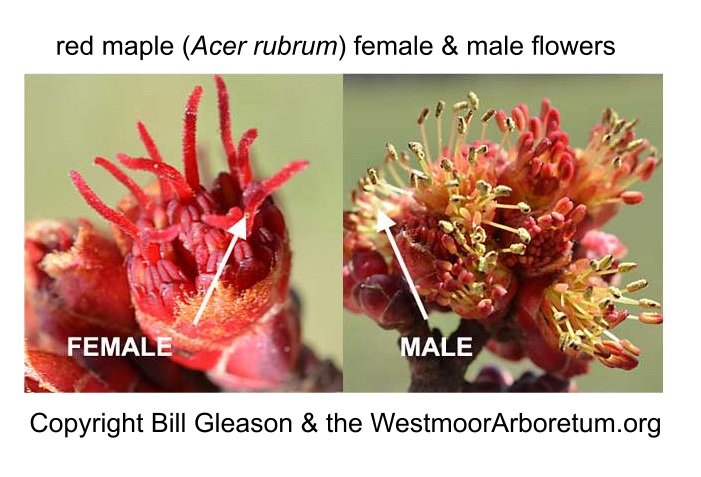
Fruit / Seeds
Red maple fruit is a red, winged, seed known as a samara. Red maples have double samaras.
The wings allow them to get carried by the wind in a helicopter fashion.
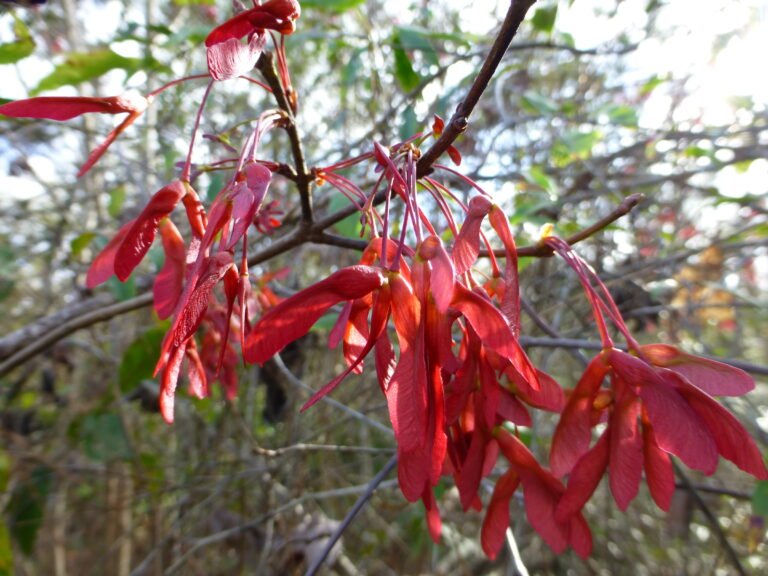
Habitat
Red maple occurs naturally in moist forests, swamps, and riparian areas.
Native Range
In Florida red maple is found naturally occurring throughout the entire state with the exception of Miami-Dade and Hendry Counties.
In the United States red maple is native to the following states – AL, AR, CT, DC, DE, FL, GA, IA, IL, IN, KY, LA, MA, MD, ME, MI, MN, MO, MS, NC, NH, NJ, NY, OH, OK, PA, RI, SC, TN, TX, VA, VT, WI, and WV.
Landscape Use
In the home landscape red maple is grown as a fast growing shade tree, a wildlife habitat tree, and a maple syrup tree.
It can grow in full sun to part shade with moist to wet soils. It does not tolerate standing water for long periods of time. It can grow in drier conditions if kept watered during periods of drought.
In ideal settings red maple attains a mature height of 100 feet in ideal conditions. Less ideal settings produce trees that grow to 60 to 90 feet. Red maple has root adaptability that allows it to adapt to almost any soil type and moisture.
In dry settings it sends roots deep into the ground for water, and in wetter conditions it grows more shallow roots. This adaptability allows it to grow very fast.
The brilliant red fruit, called samaras, make this tree stand out in the late fall and early winter landscape.
Wildlife Use
In Central Florida many migrating, and full time resident, birds such as the goldfinch, Carolina chickadee, grosbeaks, and yellow-bellied sapsucker, rely on maple seeds, sap, buds, flowers, and foliage for food as well as nest building materials.
Sapsuckers consume the syrup and maintain open “wells” in the trees that provide for many other wildlife that love the taste of maple syrup including ruby-throated hummingbirds. [2]
Game birds such as wild turkey and bobwhite quail consume the buds, seeds and twigs.
Many mammals, such as black bear, beaver, rabbit, raccoon, flying squirrels, gray squirrels, rely on maple as well, and consume the seeds, flowers, bark, and twigs. White tailed deer eat the foliage and young twigs of maple trees.
Native mice and rats eat, and store, the seeds.
Maple flowers attracts bees. [3]
The cecropia silkmoth (Hyalophora cecropia) uses maples as a larval host plant.
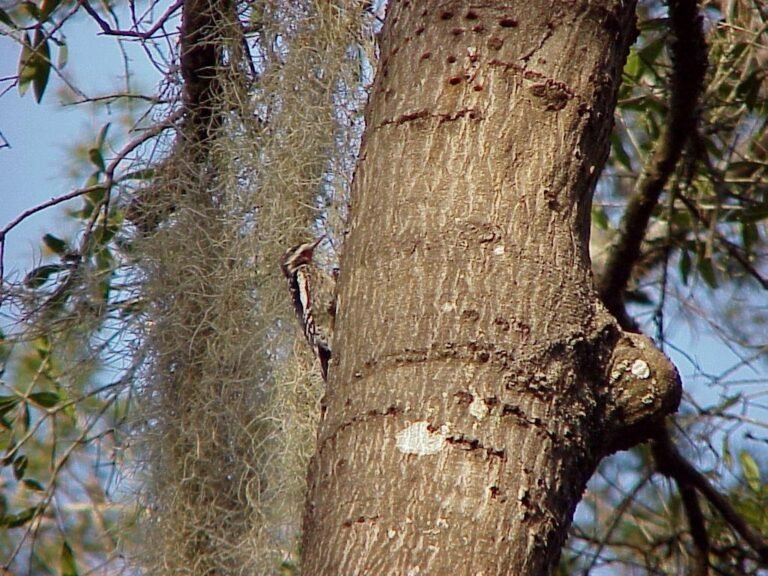
Human Use
Maple syrup has long been used by many people as a sweetener.
“Maple syrup is a natural source of sugar and can be used in many recipes to make yummy treats and foods. The best part is that it is relatively easy to obtain and simple to make. The required components to produce maple syrup include: (1) correct-sized trees in the Acer genus, (2) the right temperatures for sap flow, and (3) the equipment to collect and process sap.” [4]
Propagation
It can be grown from seed, cuttings and transplants. Cutting should be made from the tip of the branches. Saplings can be transplanted at just about any size if kept watered until established and recovered from the shock.
Maple seeds require a period of warm-moist stratification followed by cool stratification although some germination is possible with freshly fallen seeds. The outer coating of the samara does not need to be removed.
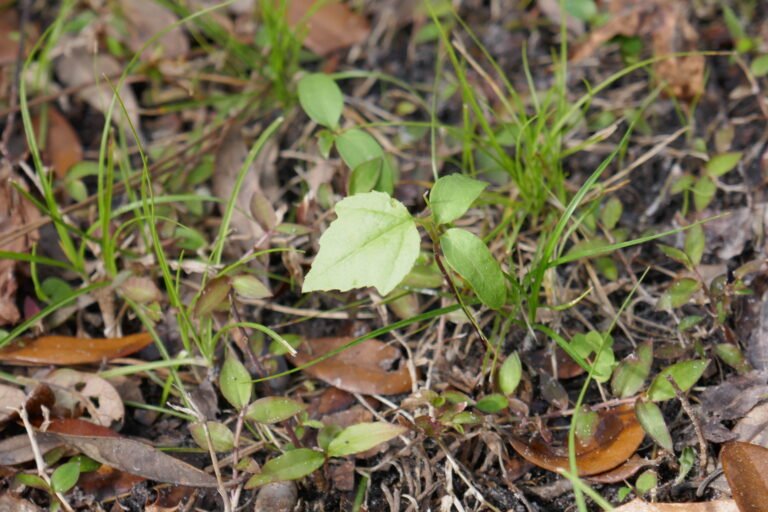
Footnotes
[1] November–December 2012 District Tree Named Florida Champion. Southwest Florida Water Management District. Accessed: 1 May 2024. [https://www.swfwmd.state.fl.us/blog/watermatters-magazine/56/district-tree-named-florida-champion#:~:text=Ace%2C%20short%20for%20its%20scientific,species%20in%20the%20United%20States]
[2] Deinlein, Mary. August 15, 2003 The Master Sap Tapper. Smithsonian’s National Zoo & Conservation Biology Institute. Accessed: 1 May 2024. [https://nationalzoo.si.edu/migratory-birds/news/master-sap-tapper]
[3] Alexander C. Martin, Herbert S. Zim, et al.. American Wildlife and Plants: A Guide To Wildlife Food Habits. Oct 5, 2011. Print. [https://amzn.to/3QmaDxh – Sharons Florida Amazon Associate link]
[4] Mathews, Jesse. April 2023. Producing Maple Syrup From Boxelder and Norway Maple Trees. Utah State University Extension. Accessed: 1 May 2024. [https://extension.usu.edu/forestry/files/publications/utah-forest-facts/043-producing-maple-syrup.pdf]
